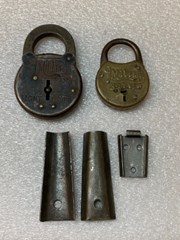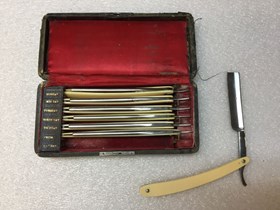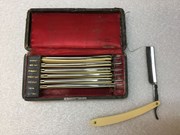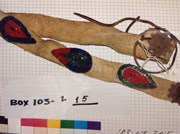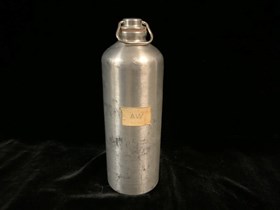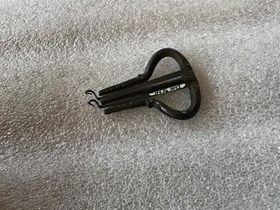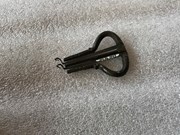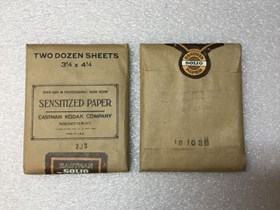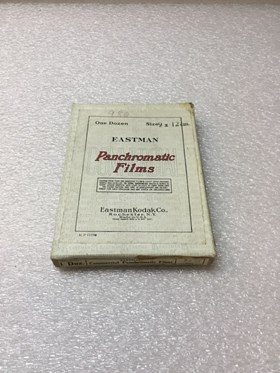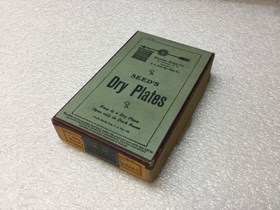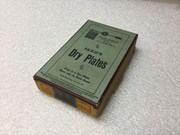Narrow Results By
- Date
- 1907 – 1920
- Material
- metal;
- Catalogue Number
- 102.04.0599 a-e
- Description
- Two metal Miller Lock Co. padlocks, one larger than the other, and three pieces of metal that serve an unknown purpose. The larger lock has the manufacturer details engraved along the curved arm, “MILLER” engraved in a decorative scroll on the body above the key hole, and “EIGHT LEVER” engraved bel…
1 image
- Title
- Padlock
- Date
- 1907 – 1920
- Material
- metal;
- Dimensions
- 1.1 x 6.2 x 9.4 cm
- Description
- Two metal Miller Lock Co. padlocks, one larger than the other, and three pieces of metal that serve an unknown purpose. The larger lock has the manufacturer details engraved along the curved arm, “MILLER” engraved in a decorative scroll on the body above the key hole, and “EIGHT LEVER” engraved below the key hole. The smaller lock has “MILLER” in a decorative scroll and “3-LEVER” engraved above the key hole. Both locks have several brass studs throughout the fronts and backs. The three extra metal pieces all have small holes drilled in them, two are longer and tapered at one end and curve in a semi-circle, the third is mostly flat with the two long sides folded up and towards the center and has a small hook at one short end.
- Subject
- locks
- protection devices
- Credit
- Gift of Bill Mather, Edmonton, 1991
- Catalogue Number
- 102.04.0599 a-e
Images
This material is presented as originally created; it may contain outdated cultural descriptions and
potentially offensive content.
Read more.
- Date
- 1900 – 1920
- Material
- leather; fabric; metal; plastic; wood;
- Catalogue Number
- 103.02.0150
- Description
- Hard leather box for days-of-the-week straight razors. The box has a hinged lid held closed with a small metal clasp and the interior is lined with red velvet. The razors sit in designated slots, some spaced on the right with small pieces of wood, with the days of the week embossed in gold on leath…
1 image
- Title
- Kit Razor
- Date
- 1900 – 1920
- Material
- leather; fabric; metal; plastic; wood;
- Dimensions
- 3.4 x 8.6 x 18.9 cm
- Description
- Hard leather box for days-of-the-week straight razors. The box has a hinged lid held closed with a small metal clasp and the interior is lined with red velvet. The razors sit in designated slots, some spaced on the right with small pieces of wood, with the days of the week embossed in gold on leather down the left-hand side. The razors themselves have plastic handles with [most likely] stainless steel blades that have a small decoration on the handle beside the blade with “R. SCHLAG N.Y.” etched on one side and “EXTRA FINE MADE IN GERMANY” on the other. Handle with care, razors are very sharp.
- Credit
- Gift of Robert Crosby Family, Banff, 1998
- Catalogue Number
- 103.02.0150
Images
This material is presented as originally created; it may contain outdated cultural descriptions and
potentially offensive content.
Read more.
- Date
- 1900 – 1920
- Material
- skin; glass
- Catalogue Number
- 103.07.3015
- Description
- Narrow buckskin belt with commercially prepared hide ties. Six beaded teardrop shapes in various colours sewn onto belt. Many pointed hide medallion at both ends.
1 image
- Title
- Beaded Belt
- Date
- 1900 – 1920
- Material
- skin; glass
- Dimensions
- 4.5 x 75.0 cm
- Description
- Narrow buckskin belt with commercially prepared hide ties. Six beaded teardrop shapes in various colours sewn onto belt. Many pointed hide medallion at both ends.
- Subject
- Indigenous
- regalia
- beadwork
- Credit
- Gift of Catharine Robb Whyte, O. C., Banff, 1979
- Catalogue Number
- 103.07.3015
Images
This material is presented as originally created; it may contain outdated cultural descriptions and
potentially offensive content.
Read more.
- Date
- 1902 – 1953
- Material
- metal
- Catalogue Number
- 103.09.1286
- Description
- Canadian Artillery cap badge inscribed “ Ubique Quo Fas et Glorioa Ducunt” Latin for “Everywhere Whither Right and Glory Lead” the mantra of the Artillery. Crowned with the Tudor Crown which was used pre 1953 and replaced by the Saint Edwards Crown on the authority of Queen Elizabeth II.
1 image
- Title
- Cap Badge Pin
- Date
- 1902 – 1953
- Material
- metal
- Dimensions
- 5 x 7 cm
- Description
- Canadian Artillery cap badge inscribed “ Ubique Quo Fas et Glorioa Ducunt” Latin for “Everywhere Whither Right and Glory Lead” the mantra of the Artillery. Crowned with the Tudor Crown which was used pre 1953 and replaced by the Saint Edwards Crown on the authority of Queen Elizabeth II.
- Credit
- Gift of Harold C. Whyte, Penticton, 2017
- Catalogue Number
- 103.09.1286
Images
This material is presented as originally created; it may contain outdated cultural descriptions and
potentially offensive content.
Read more.
- Date
- 1900 – 1925
- Material
- wood
- Catalogue Number
- 104.20.0235
- Description
- Wooden fork with smoothly carved handle and knob at end. Cluster of four long sharp tines in square from knob carved at other end of handle.
1 image
- Title
- Fork
- Date
- 1900 – 1925
- Material
- wood
- Dimensions
- 2.4 x 1.9 x 30.9 cm
- Description
- Wooden fork with smoothly carved handle and knob at end. Cluster of four long sharp tines in square from knob carved at other end of handle.
- Credit
- Gift of Catharine Robb Whyte, O. C., Banff, 1979
- Catalogue Number
- 104.20.0235
Images
This material is presented as originally created; it may contain outdated cultural descriptions and
potentially offensive content.
Read more.
- Date
- later than 1908
- Material
- metal; aluminum
- Catalogue Number
- 104.20.1311
- Description
- Silver metal bottle with screw lid. Lid has hanging loop and comes off completely. on one side it has a piece of tape with initials “AW” . Stamped on bottom is “SIGG Switzerland.”
1 image
- Title
- Water Bottle
- Date
- later than 1908
- Material
- metal; aluminum
- Dimensions
- 24.5 x 8.0 cm
- Description
- Silver metal bottle with screw lid. Lid has hanging loop and comes off completely. on one side it has a piece of tape with initials “AW” . Stamped on bottom is “SIGG Switzerland.”
- Subject
- climbing
- mountaineering
- camping
- Credit
- Gift of Arnold Wexler (Estate), Allentown, United States, 1999
- Catalogue Number
- 104.20.1311
Images
This material is presented as originally created; it may contain outdated cultural descriptions and
potentially offensive content.
Read more.
- Date
- 1900 – 1930
- Material
- metal
- Catalogue Number
- 104.36.0003
- Description
- Lyre shaped cast iron frame with a third cast iron leg from the top of the harp down the middle between the outer legs. A double, flat, flexible, thin, vibrating tongue passes down on either side of the central leg to the end of the harp where the ends turn up at sharp right angles, ending in wire …
1 image
- Title
- Jew's Harp
- Date
- 1900 – 1930
- Material
- metal
- Dimensions
- 2.2 x 5.6 x 6.9 cm
- Description
- Lyre shaped cast iron frame with a third cast iron leg from the top of the harp down the middle between the outer legs. A double, flat, flexible, thin, vibrating tongue passes down on either side of the central leg to the end of the harp where the ends turn up at sharp right angles, ending in wire like hooks. The flexible tongue tapers from .3 cm wide to less than .1 cm at the hooked end. A series of three small, shallow, notches in the middle of each outer leg on the under side.
- Subject
- Whyte home
- households
- entertainment
- pastime
- Annie White
- music
- sound
- song
- accessories
- equipment
- Credit
- Gift of Catharine Robb Whyte, O. C., Banff, 1979
- Catalogue Number
- 104.36.0003
Images
This material is presented as originally created; it may contain outdated cultural descriptions and
potentially offensive content.
Read more.
- Date
- 1905 – 1924
- Material
- paper;
- Catalogue Number
- 104.41.0200 a,b
- Description
- Two packages of 3 1/4 x 4 1/4 Kodak Sensitized Paper, also known as Solio Paper, in brown paper wrapping - unopened. Details of the contents stamped on the front in black ink, and the packages are held closed with a brown, orange, and white “EASTMAN SOLIO PAPER” sticker that wraps over the bottom e…
1 image
- Title
- Photo Paper
- Date
- 1905 – 1924
- Material
- paper;
- Dimensions
- 0.9 x 9.4 x 11.8 cm
- Description
- Two packages of 3 1/4 x 4 1/4 Kodak Sensitized Paper, also known as Solio Paper, in brown paper wrapping - unopened. Details of the contents stamped on the front in black ink, and the packages are held closed with a brown, orange, and white “EASTMAN SOLIO PAPER” sticker that wraps over the bottom edge from front to back. Faded stamps on the backs are mostly illegible, but the expiration date of “MAY 15 1924” is visible.
- Credit
- Gift of Robert Crosby Family, Banff, 1998
- Catalogue Number
- 104.41.0200 a,b
Images
This material is presented as originally created; it may contain outdated cultural descriptions and
potentially offensive content.
Read more.
Panchromatic Film
https://archives.whyte.org/en/permalink/artifact104.41.0201
- Date
- 1906 – 1923
- Material
- cardboard; paper;
- Catalogue Number
- 104.41.0201
- Description
- One box of a dozen 9x12cm Eastman Commercial Panchromatic Films - unopened. The box has a large paper label on the lid containing the manufacturer and development details throughout, as well as “9.80” written in pencil at the top. The edges and bottom of the box are sealed with brown paper adhesive…
1 image
- Title
- Panchromatic Film
- Date
- 1906 – 1923
- Material
- cardboard; paper;
- Dimensions
- 1.5 x 10.0 x 13.7 cm
- Description
- One box of a dozen 9x12cm Eastman Commercial Panchromatic Films - unopened. The box has a large paper label on the lid containing the manufacturer and development details throughout, as well as “9.80” written in pencil at the top. The edges and bottom of the box are sealed with brown paper adhesive tape, the right-hand side is stamped with “DEVELOP BEFORE APRIL 1923.”Panchromatic film is a kind of black-and-white emulsion that is sensitive to all visible light wavelengths and creates realistic photographs - it could also be used successfully for colour and black-and-white motion pictures as early as 1913. One downside to panchromatic film was that it had to be developed in complete darkness as it was sensitive to the red lights standard in many darkrooms.
- Credit
- Gift of Robert Crosby Family, Banff, 1998
- Catalogue Number
- 104.41.0201
Images
This material is presented as originally created; it may contain outdated cultural descriptions and
potentially offensive content.
Read more.
Exposure Plates
https://archives.whyte.org/en/permalink/artifact104.41.0207
- Date
- 1902 – 1920
- Material
- cardboard; paper; glass;
- Catalogue Number
- 104.41.0207
- Description
- Box of one dozen 3 1/4 x 5 1/2 glass Seed’s Dry Plates with cut paper adhesive tape around the edges and bottom and manufacturer details printed on a pale green background throughout the lid. These dry plates were invented by M.A. Seed in 1879 and became very popular with photographers as the plate…
1 image
- Title
- Exposure Plates
- Date
- 1902 – 1920
- Material
- cardboard; paper; glass;
- Dimensions
- 3.0 x 9.3 x 15.0 cm
- Description
- Box of one dozen 3 1/4 x 5 1/2 glass Seed’s Dry Plates with cut paper adhesive tape around the edges and bottom and manufacturer details printed on a pale green background throughout the lid. These dry plates were invented by M.A. Seed in 1879 and became very popular with photographers as the plates came pre-prepared with the emulsion layer already applied - prior to “dry” plates, photographers would need portable dark rooms in which they would create their liquid emulsions prior to taking a photograph [known as “wet” plates]. Seed’s dry plates still required they be opened in a dark room, but this could be accomplished in the field by placing a dark sheet over the camera while loading and unloading the plates. In 1902, Eastman Kodak purchased Seed’s company [Seed Dry Plate Co.], but continued to capitalize on his name due to its reputation among consumers.
- Credit
- Gift of Robert Crosby Family, Banff, 1998
- Catalogue Number
- 104.41.0207
Images
This material is presented as originally created; it may contain outdated cultural descriptions and
potentially offensive content.
Read more.


